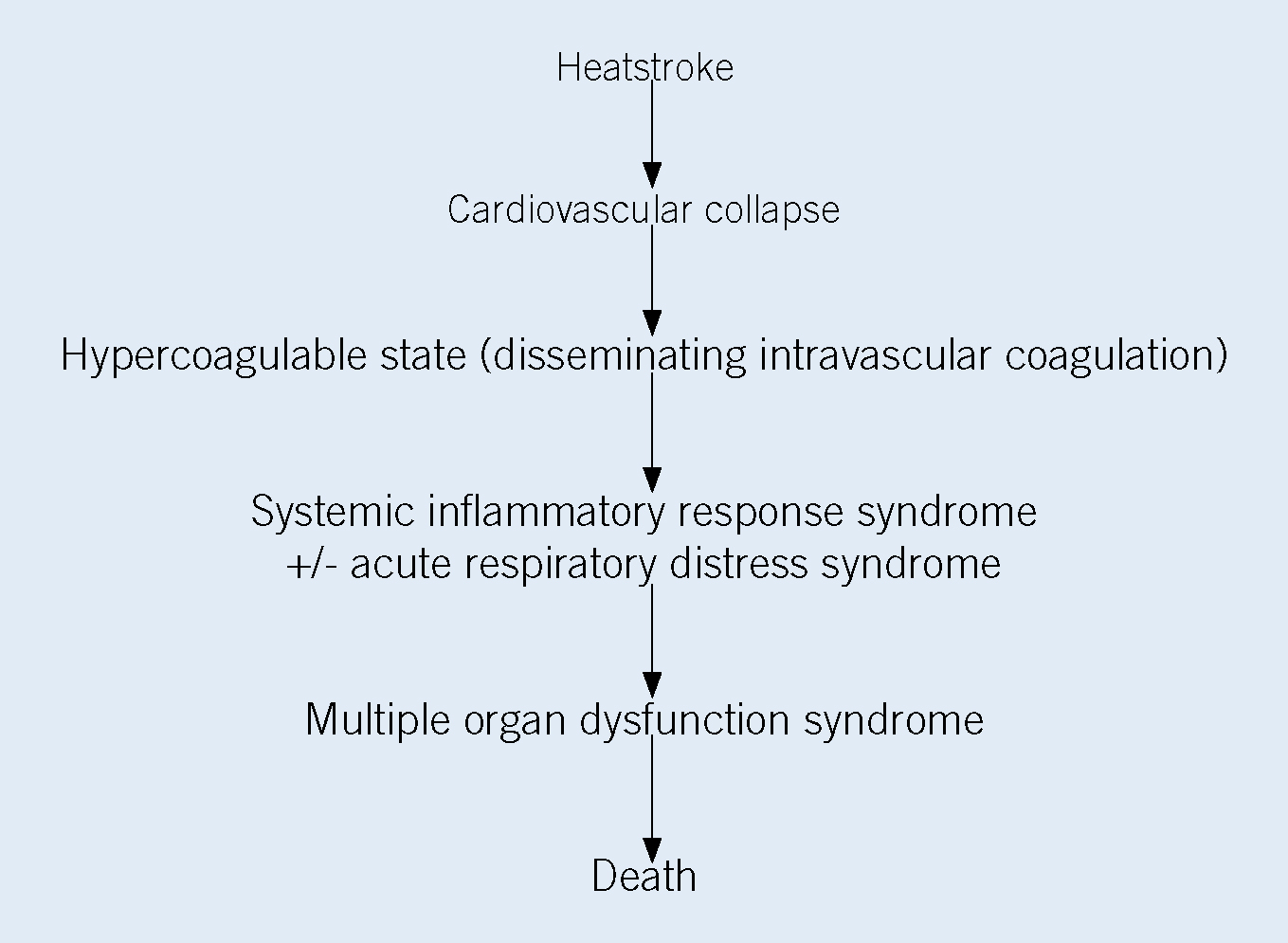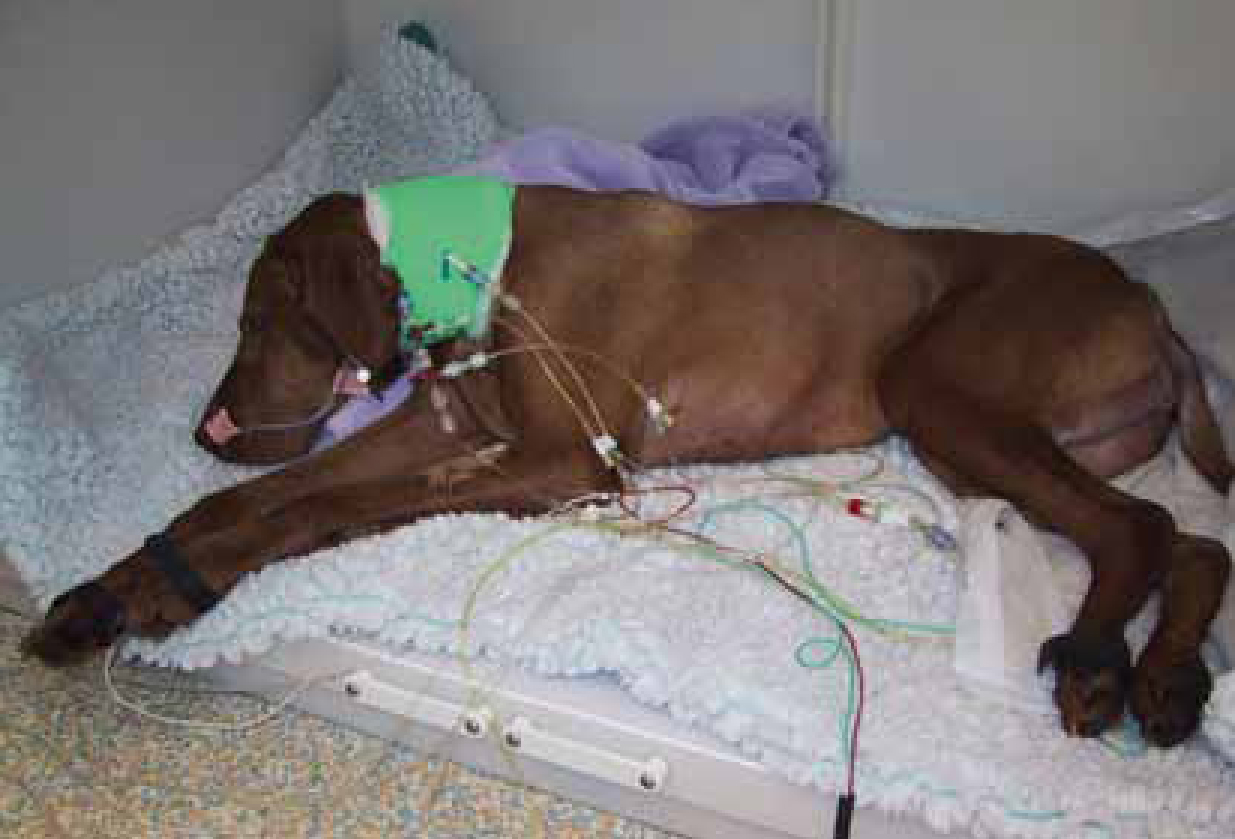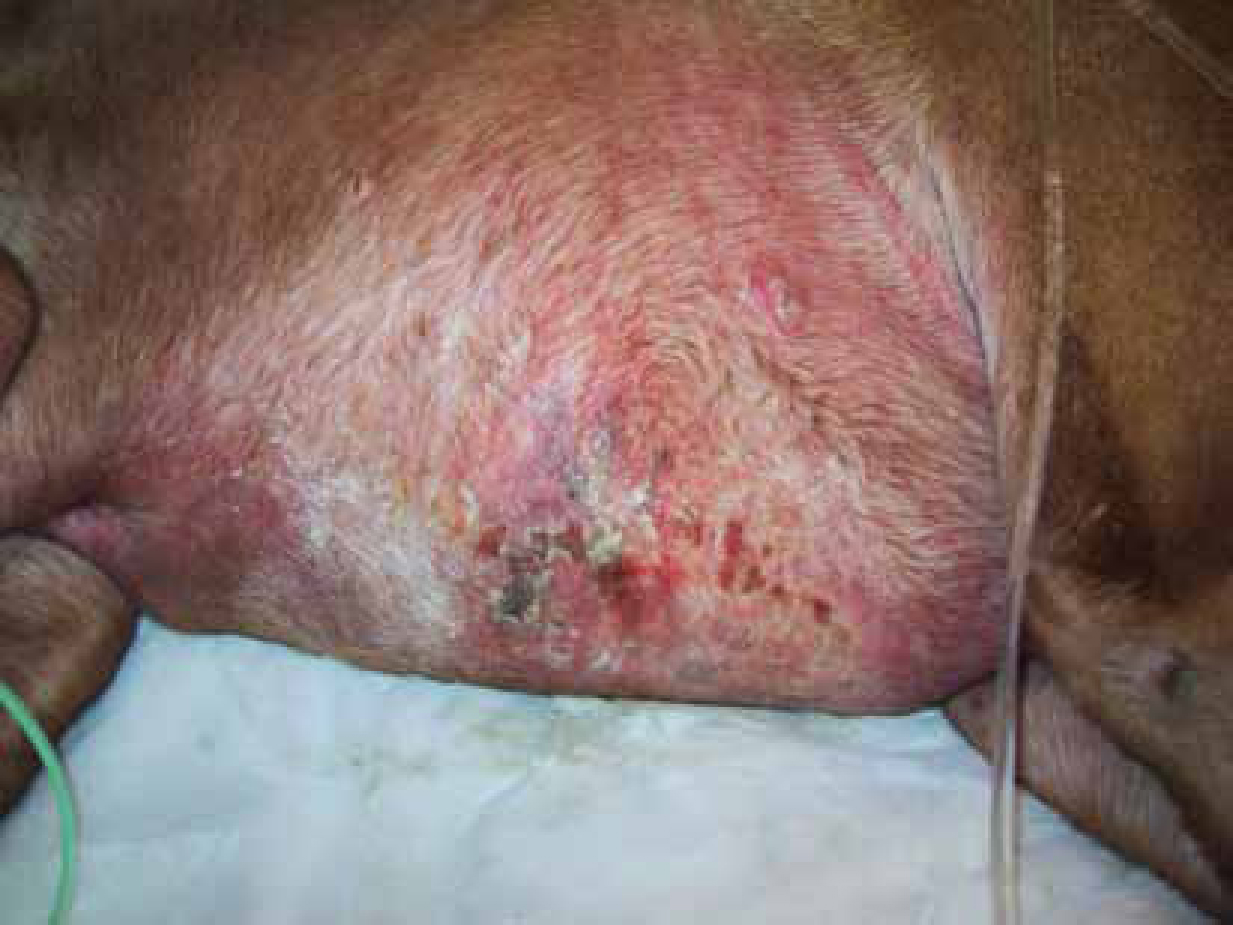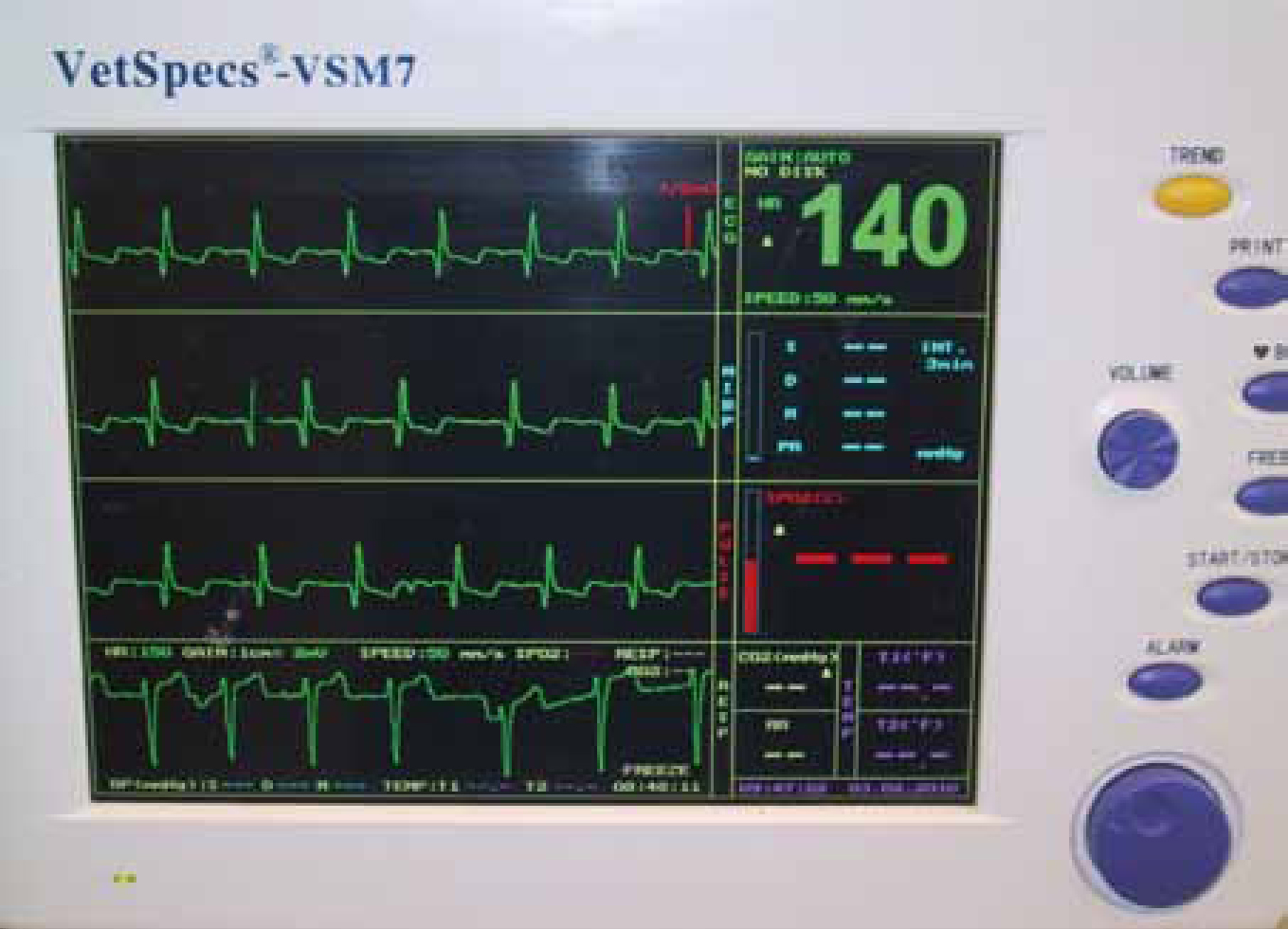Heatstroke is a condition that usually presents as an emergency, and that requires rapid recognition and treatment including intensive care. Prognosis is guarded particularly when systemic inflammatory response syndrome (SIRS) or multiple organ dysfunction syndrome (MODS) develop. A retrospective study indicated that a half to a quarter of all heatstroke patients die (Smarick, 2008).
This article looks at heatstroke and its effect on body systems in the small animal patient. It looks at the parameters which indicate heatstroke, emergency treatment to implement, and ongoing intensive care and nursing needed for a favourable outcome.
Definition
Heatstroke is usually defined as a body temperature of greater than 41°C (Smarick, 2008). It should not however be confused with pyrexia or fever (an elevation of temperature above the normal range). Pyrexia is a normal acute phase response to infection or inflammation and should not lead to further pathologies.
Heatstroke can be further defined as being either exertional (EHS), e.g. from strenuous exercise or nonexertional (NEHS), e.g. the dog left in the car on a hot day. Heatstroke in the veterinary patient is being increasingly described as a hyperthermia associated with SIRS leading to MODS (Smarick, 2008), while in human medicine it is a body temperature higher than 41.1°C associated with neurological dysfunction (Helman and Habel, 2009).
Physiology
Thermoregulation is controlled by the hypothalamus which uses sensory cells to detect the temperature of circulating blood and the cutaneous tissue. The body responds to a rise in temperature by initiating cooling methods which take the form of conduction, convection, evaporation, and radiation. In animals this is seen as increased panting, sweating through foot pads, peripheral vasodilation, and increased cardiac output. However, in some animals these systems may not be effective because of factors such as coat/hair thickness, obesity, airway compromise (brachycephalic breeds) or laryngeal paralysis (Smarick, 2008). It is important to remember that heatstroke does not just occur through an animal's inability to lose heat. NEHS can occur when heat load is increased by such conditions as eclampsia, tremorgenic intoxication and seizuring (Smarick, 2008).
In response to increased temperature the body will initiate its own protective mechanisms, the acute phase response and intracellular heat shock proteins. The acute phase response is a release of pro-inflammatory and anti-inflammatory cytokines. Heat shock proteins protect cells by preventing denaturation of intracellular proteins and cell membranes. These heat shock proteins, in particular heat shock protein 70 (HSP-70), allow cells to endure the stress of their environment, i.e. thermal injury. It is thought that HSP-70 is responsible for the neurologic protection seen in dogs with heatstroke which is not seen in humans (Reineke, 2009). In high temperatures these mechanisms fail, starting a chain reaction culminating in cellular dysfunction or death (Figure 1).

Initial assessment
Most heatstrokes are diagnosed on the history provided by the client. This is usually because by the time the patient is presented the owners have already initiated cooling methods, particularly if they have already sought veterinary advice. This generally means that the patient presents with a normal or in some cases even a sub-normal temperature, not the 41°C plus that heatstroke is usually defined by. It is, however, important to continue to treat presenting cases as an emergency even though their temperature may be normal. It is not possible to know what body temperature was actually reached and for how long the body temperature remained above the heatstroke threshold, and as such the patient may still progress to develop further pathologies. Patients may show other clinical signs including incessant panting, collapse, ataxia, vomiting, diarrhoea, altered mentation, and in extreme cases coma.
Triage should be carried out quickly with a brief assessment of cardiovascular (heart rate, pulse quality, mucous membrane colour, capillary refill time) and respiratory (rate, effort, airway sounds) systems central nervous system (CNS) (observing for abnormalities) and temperature so that in those cases that present with a temperature exceeding 41°C, cooling can be initiated. A more through examination can be carried out once the patient's temperature starts to come down.
Patients will usually present with sinus tachycardia or other arrhythmias. Pulses may be weak or absent peripherally due to vasodilation, also depending on time before presentation patients may have significant fluid loss from the respiratory and/or gastrointestinal systems. Extent of fluid loss can be assessed by observing the level of the patient's dehydration and also finding out from the owners how much vomiting and/or diarrhoea the patient has had. As such these patients will present with distributive shock. Mucous membrane colour can vary from darkened with a rapid or injected capillary refill time (CRT) due to vasodilation and increased cardiac output, to pale or cyanotic with a slow or absent CRT depending on the degree of shock.
Most heatstroke patients will present with tachypnoea (they will be panting) so it can be difficult to assess their respiratory system. Some patients who will be more prone to heatstroke will have stertorous or stridorous breathing due to laryngeal paralysis or tracheal collapse and may or may not be dyspnoeic. Pulmonary crackles, heard on auscultation, may be an indication of acute respiratory distress syndrome (ARDS) or aspiration pneumonia developing, in the comatose patient.
The CNS should also be assessed by monitoring for seizures, decreased mentation, cranial nerve deficits (pupillary light response), ataxia and difficulty walking, although some findings may resolve. Heatstroke patients can present with cortical blindness, i.e. pupillary light response is normal but they have no menace response indicating that the eye is working normally and detecting the light, but that the brain may have some degree of injury as it is not responding to a menace, this should resolve in a couple of hours (Reineke, 2009).
Assessment of other body systems can be carried out once emergency treatment has been initiated.
Emergency treatment
Emergency treatment should begin with safely lowering the patient's core body temperature. If owners ring for advice before presentation then they should be advised to start cooling the animal. Hosing or sponging the animal down with cool water, not cold, should start this process, however, owners should not waste time in coming to the practice.
It has been found in human medicine that the most effective method of cooling is to wet the patient and then position fans blowing air over them (Helman and Habel, 2009). Care should be taken with comatose or recumbent patients that the fans do not blow directly into their faces, as this may cause ocular problems. Patients can be placed directly on metal surfaces, e.g. kennels or examination table, and ice packs can be used in the inguinal and axillary regions but these must be wrapped in towels to prevent cold contact burns occurring. Administration of room temperature fluids will help, but cold intravenous fluids are contraindicated as they cause vasospasm and vasoconstriction as well as feeling unpleasant. Rectal temperature should be monitored continuously or at least every 5 minutes, and cooling methods stopped when the temperature has reached 39.4°C in order to try to avoid hypothermic overshoot when the patient's temperature drops below the normal 38.3°C (Helman and Habel, 2009). If hypothermia occurs warming may be necessary. It can be difficult to warm rebound hypothermia patients as the cells in the hypothalamus may have been damaged and as such the cells' response will be dulled.
Patients will present in various stages of shock and will require fluid therapy to support their cardiovascular system. Bloods should be drawn to establish baseline biochemistry, haematology including packed cell volume/total solid proteins (PCV/TSP) and electrolytes. A coagulation analysis should also be done as these patients are at high risk of developing disseminating intravascular coagulation (DIC). It will then be possible to select the appropriate resuscitation fluid, which in most cases will be Hartmann's solution. Initially a large bore intravenous (IV) catheter will be most convenient to provide fluid therapy, although it may be necessary to place a jugular catheter or peripherally inserted central catheter (PICC) if multiple infusions are required (Figure 2).

Patients should receive boluses of fluids until cardiac parameters have normalized, fluid rates should then reflect ongoing losses. Heatstroke patients will usually develop haemorrhagic diarrhoea and are generally anorexic; appropriate fluid administration should compensate for this. If the patient has had a direct thermal injury to the skin then further fluid will be lost via exudate, this will need to be included when calculating ongoing fluid losses (Figure 3).

Fluid therapy is also very important in these cases to support the urinary system, as it is common for these patients to be in a degree of renal failure.
Heart rate and rhythm should be monitored as tachyarrhythmias are not uncommon. A continuous electrocardiogram is useful, if possible using sticky foot pads as crocodile clips can cause sores and be uncomfortable if used for long periods. The most common arrhythmias seen with this condition are ventricular premature complexes (Figure 4) and ventricular tachycardia, which should be treated in order to avoid affecting cardiac output and perfusion.

Lignocaine can be used as a bolus (2 mg/kg IV) followed by a constant rate infusion (CRI) (25–75 μg/kg/minute) if necessary (Smarick, 2008).
It may be necessary to provide oxygen supplementation to heatstroke patients if they are dyspnoeic or have pathologies, however, providing this can be problematic. Incubators, oxygen cages, hoods and masks all interfere with cooling as they prevent heat dissipation and therefore should be used with caution. If tolerated a nasal oxygen catheter or paediatric oxygen prongs are good methods of delivering oxygen therapy. If the patient resents these in any way they should not be used, as the effort of the animal to remove them may increase their temperature. Ideally arterial blood gases should be used to assess effectiveness of oxygen therapy, and if tolerated pulse oximetry.
In the comatose patient it may be necessary to place an endotracheal tube and provide positive pressure ventilation to protect the airway, and to attempt to avoid aspiration pneumonia. Patients that develop ARDS may need to be mechanically ventilated (Snyder, 2009). It should be noted that ARDS carries a high mortality rate and owners should be made aware of this, so that they can make an informed decision on treatment.
Critical care
Heatstroke patients will go on to require intensive care to support the individual body systems that have been affected by heatstroke.
Coagulation system
Disseminating intravascular coagulation (DIC) is a common syndrome that develops in heatstroke patients. Petechiae and ecchymoses can be indicators of DIC, as well as active bleeding (Reineke, 2009), e.g. haemorrhagic diarrhoea, indicating gastrointestinal bleeding. Assessment of the activated clotting time (ACT) using an istat© (Abbott, Birmingham, UK) is an easy way to monitor DIC. Normal clotting times are 90–110 seconds for dogs and 100–160 seconds for cats. If clotting times show an increasing trend, or are above 150 seconds for dogs, fresh frozen plasma (10–20 ml/kg IV) should be administered to control bleeding (Reineke, 2009). Cats can have longer activated clotting times which are however normal, so results can be more difficult to interpret. These infusions should be repeated every 12–24 hours until ACT has normalized.
PCV should also be monitored and maintained above 20%, which may mean transfusing packed red blood cells (pRBCs), so it is a good idea to blood type the patient when carrying out baseline blood tests. Ideally type-specific blood should be used and a cross match carried out before administration, to try to prevent any transfusion reactions occurring. It is important to note that although dog erythrocyte antigen (DEA) 1.1 negative pRBCs can be given to type DEA 1.1 positive patients, this may cause problems with future transfusions. This also depletes stocks of negative pRBCs; as only 40% of the dog population is negative it should be used judiciously.
Renal system
Many patients will present with an elevated blood urea nitrogen level. This may be due to decreased renal perfusion, gastrointestinal bleeding, renal failure, or a combination of all three (Reineke, 2009). Ideally blood urea nitrogen, creatinine, and electrolytes should be monitored every 12 hours, and fluid rate and type adjusted accordingly.
Urinalysis may identify the presence of casts, indicating early renal injury or myoglobinuria from muscle injury, as well as red blood cells and haemoglobin from DIC. It is particularly useful to place a urinary catheter in these patients so that ‘ins and outs’ can be monitored. This should help to identify onset of oliguric or anuric renal failure, and prevent fluid overload. Urine output should be a minimum of 2 ml/kg/hr, and higher in patients receiving higher rates of fluid therapy. In patients that develop oliguria or anuria it may be necessary to use frusemide 1–4 mg/kg boluses or as a CRI (Smarick, 2008).
Gastrointestinal system
Patients will usually suffer from vomiting and diarrhoea, which should be monitored for the presence of blood indicating DIC. This is caused by direct thermal damage, as well as poor perfusion during periods of hypovolaemia, leading to mucosal sloughing, ulceration, and ileus (Reineke, 2009). This increases the mucosal permeability and increases the risk of bacterial translocation and sepsis occurring, therefore intravenous antibiotic cover is recommended in all cases as a precaution.
Nausea and vomiting or regurgitation as a result of ileus is best controlled with a CRI of metoclopramide 1–2 mg/kg/24 hours (Reineke, 2009). Maropitant is contraindicated in patients with hepatic dysfunction.
Once the vomiting/regurgitation is controlled the patient's nutritional needs should be assessed. It is now believed that early enteral nutrition prevents further villous atrophy and helps to preserve/restore intestinal mucosa, therefore reducing bacterial translocation (Mohr et al, 2003). In these cases a nasogastric feeding tube allows suctioning to remove stomach content before feeding, when the patient is suffering from ileus. The patient can also be placed on feeding CRIs so they are trickle fed, which should avoid bloating, which can occur when they are fed with boluses. They can also receive their fluid requirements via the feeding tube using a balanced electrolyte solution, which can be administered with their food.
Analgesia
The use of analgesia will be case dependent, and the normal assessment used for pain implemented. Patients that have received direct thermal injuries to their skin will require analgesia, as this is a particularly painful condition. The most effective method of providing analgesia in these patients is via an opioid CRI. Non steroidal anti inflammatories are contraindicated due to their effect on the gastrointestinal and renal system.
It is important to remember that animals that are in pain will not recover and heal as quickly as animals that are receiving analgesia (Grant, 2006). Often the benefits of pain relief will outweigh the concerns of its use.
Nursing considerations
These patients are critically ill, but basic care and nursing must not be forgotten.
The patient may be recumbent and require appropriate care to prevent sores (particularly for those suffering from burns), and hydrostatic pneumonia occurring. Patients should be turned ideally every 4 hours and should be kept as clean and dry as possible; this can be challenging for those suffering from diarrhoea. The placement of a urinary catheter, with a collection bag, will help to prevent any urine scalding. Appropriate measures should be taken when emptying the collection bag to try to prevent any ascending urinary tract infections. Physiotherapy, as directed by the veterinary surgeon, can be used to prevent stiffness and muscle contracture.
Patients may have multiple IV catheter sites and in some cases jugular catheters or PICC lines. These should be checked daily for signs of infection or phlebitis and removed if this occurs. Patients with central lines should not be left unattended in case they get dislodged, which may lead to haemorrhage. Likewise patients with nasogastric tubes should be monitored to ensure they do not become displaced, which may lead to aspiration pneumonia. If this is suspected the CRI should be stopped immediately, and a radiograph taken to confirm the tube's position.
The patient's face should be kept clean from any ocular or nasal discharge or salivation due to nausea. Baby wipes are quite effective for this and coats should be groomed, as animals may appreciate this contact which should make them feel a bit better (personal experience). Owners can be encouraged to come and visit and carry out some of these tasks under supervision.
Conclusion
The complications associated with heatstroke make it a challenging condition to treat. Due to the multiple organs and body systems involved a guarded prognosis should be given. Early recognition and prompt treatment are key to a favourable outcome, but ultimately prevention is better than cure.
